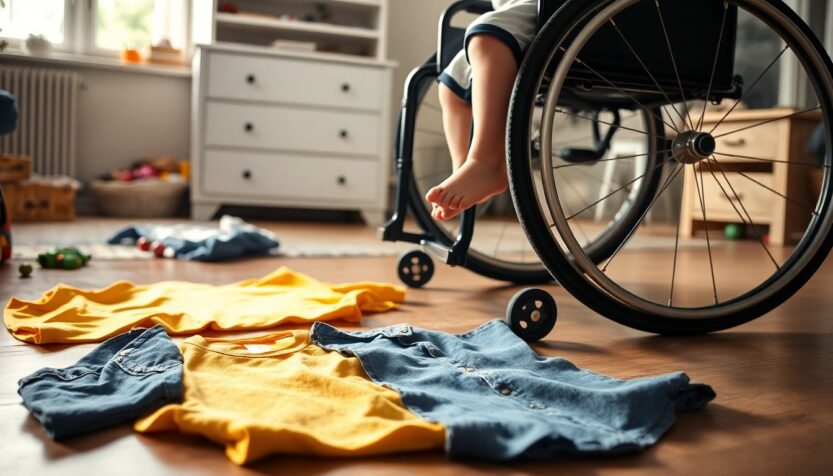After a refreshing nap, an 18-month-old boy begins an impromptu game of dress-up, scattering his shirts throughout the home. A vibrant yellow shirt finds its way to the corner, a denim oxford lands on a knee, and a ringer tee becomes a playful hat atop his head. With the dresser now empty, he eagerly climbs onto a lap. Planting one foot on the frame of a wheelchair and stretching the other for balance, he flops down onto the legs. He is pulled into a more comfortable sitting position, his head resting against the chest. Amusingly, he begins to count to five, pointing around the room without any particular purpose.
Adventures in accessibility
The next stop is the corridor leading to what is affectionately referred to as the ‘elevator room,’ which also serves as a podcast recording studio. This modest elevator accommodates a power wheelchair perfectly. Leaning forward to open the door, they back in together. With one hand, care is taken to ensure he doesn’t press any buttons while the other holds down the button to descend, as this particular elevator only operates when a rider actively presses the button.
Upon reaching the ground level, footrests are used to nudge the elevator door open, and they roll into the family room. The next destination is the kitchen, where a bottle is filled with water, accompanied by a fruit pouch and a granola bar. He arches his back, signaling readiness to hop down, and legs are adjusted to let him slide off like it’s an exciting slide at a playground. However, when snacks are pursued, he flaps his arms in protest, exclaiming, ‘All done! All done! All done!’
The power of books in play
As he busies himself organizing the collection of books, he carefully places some on the sofa, some on a lap, and others by the dog food. His fascination with literature is evident as he clings to a copy of Virginia Woolf, reminiscent of how he was captivated by Salinger just yesterday. But as he reaches for an Omar El Akkad book, a heavy Richard Powers novel lands on his tiny toes. He freezes, caught by surprise, and moments later, tears well up in his eyes, leading to a full-blown scream. Comfort is offered by rolling over and lifting him onto a lap. Instead of facing outward, he burrows in, his wet cheeks pressed against the chest. One hand grasps hair while the other gently strokes the forearm. He gradually calms down as soothing words are whispered and gentle kisses are placed on his soft, fine hair.
Reflections on accessibility
This seemingly ordinary moment is, in fact, a miracle. Having lived with a disability for 14 years, a suitable home that accommodates needs has only recently been found. In an article penned for The Atlantic, the challenges of locating accessible housing were discussed, a story not retold here. Nonetheless, the piece concluded with an incident from earlier this spring when a minor fall left the child unreachable due to the lack of an elevator in the previous home. Countless instances like that have resulted in missing precious moments with the child over the past nine years.
The family now resides in a century-old brick house in Toronto, where the entrance features a large metal device known as a Vertical Platform Lift (VPL). This contraption may be an eyesore and emits a loud noise, but it is a vital asset for the wheelchair. After moving in last June, five weeks were dedicated to renovations with an excellent contractor to enhance accessibility. The dining room now accommodates a sizable elevator box, and the backyard, once filled with space for a swing set, is now primarily a concrete pad with another lift leading to the garage.
Living with dignity
Sometimes, a tinge of shame arises while surveying the home, now altered with buttons, rods, and the grinding sounds of the elevator. Justifying the changes made to the very architecture of the living space to facilitate simple tasks like preparing lunch or doing laundry can be daunting. Yet, this house stands as a physical testament to dignity and the value of aspirations and presence.
For years, the distinction between illness and disability remained a struggle, often leading to feelings of entrapment in a home that didn’t cater to needs. Despite appearing normal when standing, the toll on the body becomes evident after just a few moments. Blurred vision, clammy skin, and distorted hearing are symptoms of physical stress. In the previous home with stairs, managing them was possible but only a couple of times a day.
Embracing change
The societal pressures of ableism and the belief in individualism can lead to the notion that if one can occasionally stand, adapting the body instead of the surroundings is preferable. There was a misguided hope of healing oneself to use the home independently. In addition, the financial burden of renovations can be daunting; the family was fortunate to afford the necessary changes after years of saving.
Just last week, the daughter attended camp, and a feeling of dizziness increased in the mornings. Navigating the stairs to get her ready before 9:00 a.m. was a challenge that proved insurmountable. For years, styling her hair while lying in bed became the norm, bidding her farewell from the room. Now, anticipation builds at the front door, reminding her to use the restroom one last time, rolling through the family room in search of her visor, and ensuring her water bottle is leak-proof.

